harmful when it feeds on pollen and neutral to beneficial when it feeds on nematodes and fungi in the nest
Kuzinia Zachvatkin, 1941Zachvatkin, 1941:
Zachvatkin, A. A. 1941. Tiroglifoidnue kleshchi Tyroglyphoidea [=Tyroglyphoid mites Tyroglyphoidea]. In Fauna SSSR: Paukoobraznuye, ed. S. A. Zernov, 475. Moscow-Leningrad: Akademiya Nauk SSSR (translated to English in a separate publication).
Superorder Acariformes » Order Sarcoptiformes » Suborder Oribatida » Infraorder Desmonomata » Hyporder Astigmata » Family Acaridae » Genus Kuzinia
Hypopus laevis Dujardin, 1849
bumble bee mite
Adult: Hysterosomal setae c1 unbarbed, positioned often very close to seta d1 (Fig. 11). Tarsi tanned (Fig. 10), with a distinct dorsal ridge.
Phoretic phoretic:
Pertaining to phoresy; using another organism (i.e., a host) for dispersal to new habitats. Phoresy can be distinguished from parasitism because feeding typically does not occur during phoresy.
deutonymph: Tarsal setae aa I present (Fig. 4). Setae ba I absent, ba II present (Fig. 4). “Saucer” at the end of tarsal setae e I-II present (Fig. 4). External conoidal setae (ps2) of attachment organattachment organ:
Complex unpaired structure in phoretic deutonymphs of Astigmata situated on the posteroventral end of the body that serves for attachment to the host during phoresy. In deutonymphs phoretic on insects, attachment organ consists of a vestigial anal opening and two types of attachment elements: true suckers that create negative pressure and conoids that create adhesive forces. Not to be confused with pedicel.
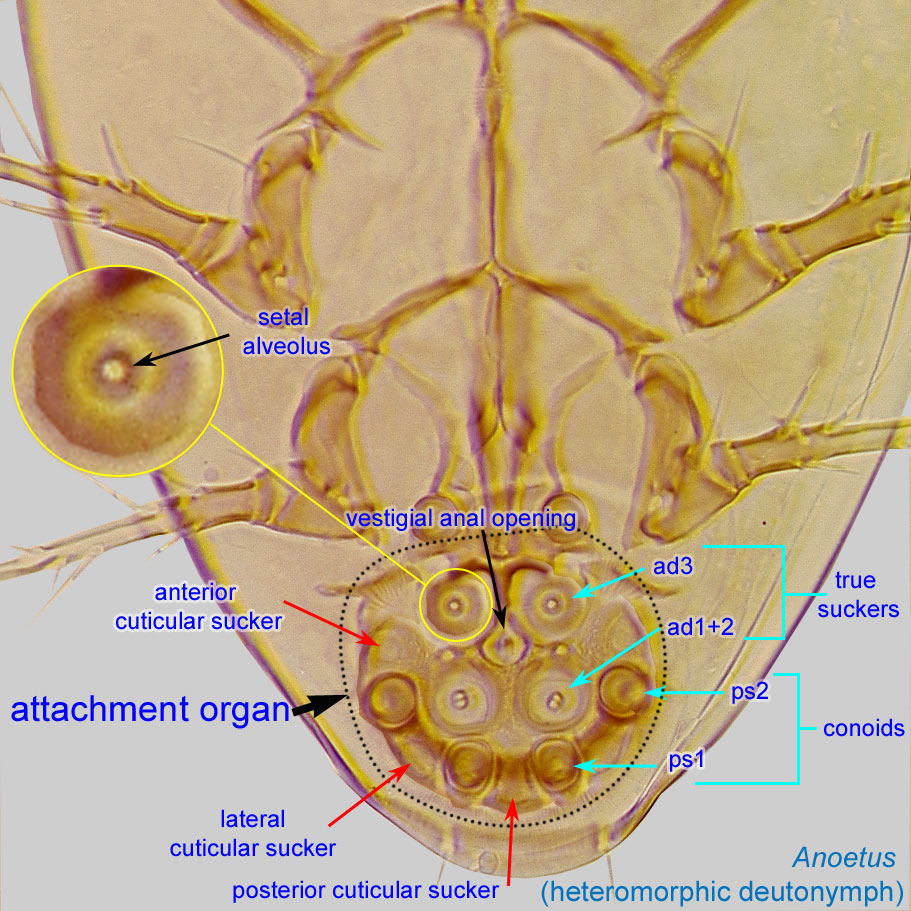 slightly anterior to median suckers (ad1+2) (Fig. 5); ps2 not accompanied by long endosclerites (internal sclerotized structures) (Fig. 5). Solenidionsolenidion:
slightly anterior to median suckers (ad1+2) (Fig. 5); ps2 not accompanied by long endosclerites (internal sclerotized structures) (Fig. 5). Solenidionsolenidion:
Thin-walled, terminally rounded or pointed filiform or peglike structure that is not birefringent in polarized light (unlike common setae in Acariformes). Often appears striated because of its internal structure. Found on the palpal tarsus on the gnathosoma and may also occur on the tarsus and tibia, less frequently on the genu, and occasionally on the femur of legs I-IV. In Acariformes, leg solenidia often arise from unsclerotized areas.
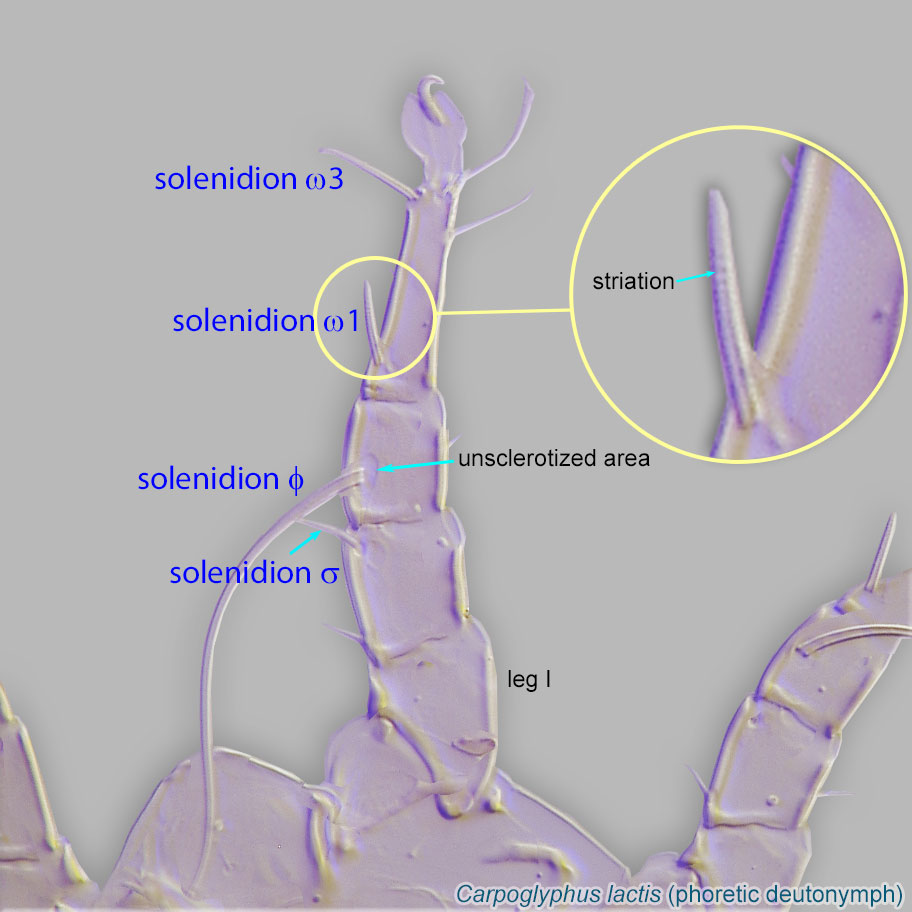 σ III present (Fig. 5). Coxal setae 1a, 3a minute, filiform (Figs. 3, 5). TarsiTarsus:
σ III present (Fig. 5). Coxal setae 1a, 3a minute, filiform (Figs. 3, 5). TarsiTarsus:
Terminal segment (also known as podomere or palpomere) of legs or palps. In Parasitoformes it can be subdivided into telotarsus and basitarsus.
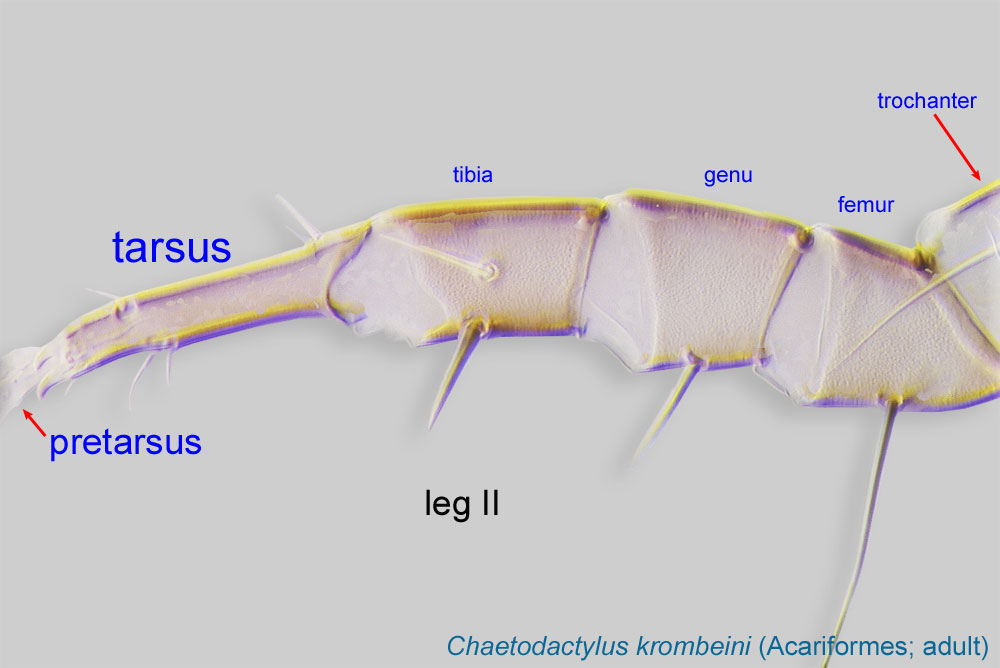 short, not more than 3 times longer than width (Fig. 4). Apical tarsal seta q (p’) I-II present, foliate (Fig. 4). Gnathosomagnathosoma:
short, not more than 3 times longer than width (Fig. 4). Apical tarsal seta q (p’) I-II present, foliate (Fig. 4). Gnathosomagnathosoma:
Division of body anterior to the propodosoma bearing two pairs of appendages (palps and chelicerae).
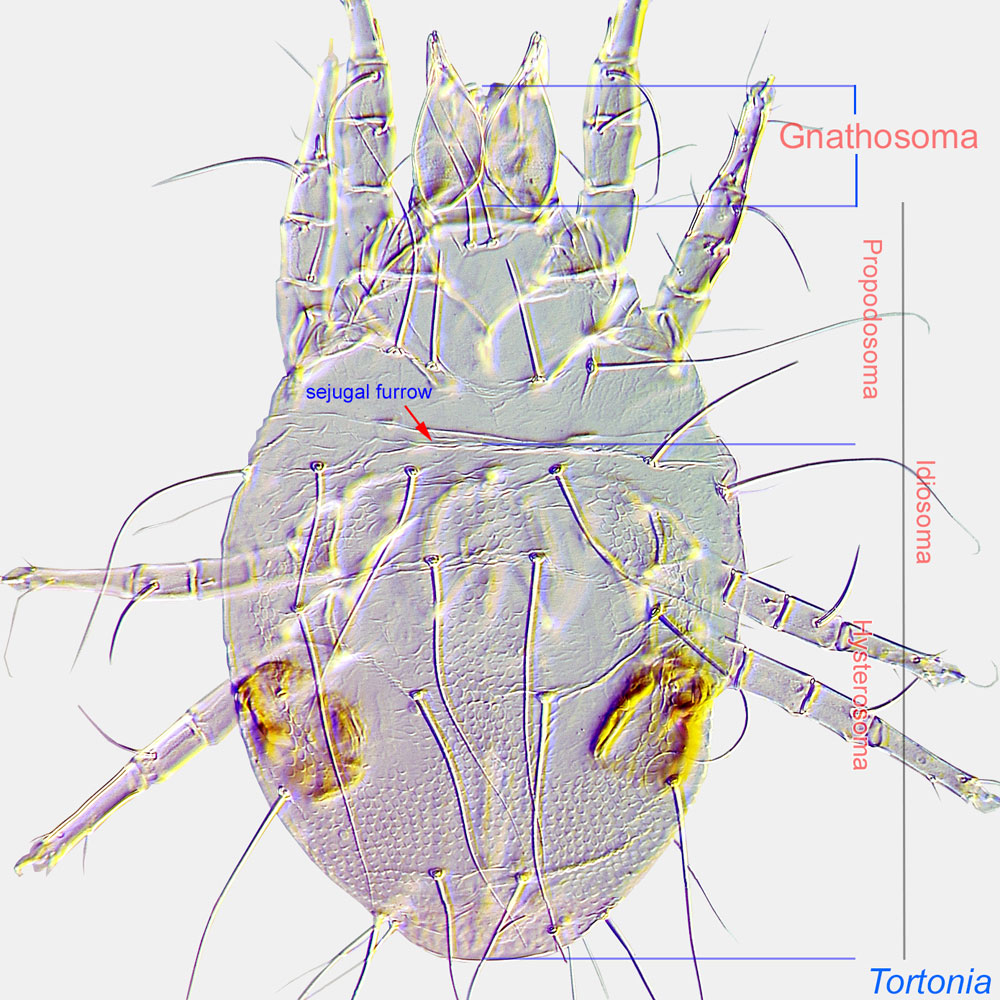 variable, either typical (base present, with 2 pairs of setae) (Fig. 3) or reduced (base absent, 1 pair of setae).
variable, either typical (base present, with 2 pairs of setae) (Fig. 3) or reduced (base absent, 1 pair of setae).
Adult: Tarsal setae aa I present (Fig. 10) (correlates with character in phoreticphoretic:
Pertaining to phoresy; using another organism (i.e., a host) for dispersal to new habitats. Phoresy can be distinguished from parasitism because feeding typically does not occur during phoresy.
deutonymphsdeutonymph:
Ontogenetic stage between protonymph and tritonymph (or adult, if tritonymph is absent). See <a href="index.cfm?pageID=1720">Life stages page</a> for more details.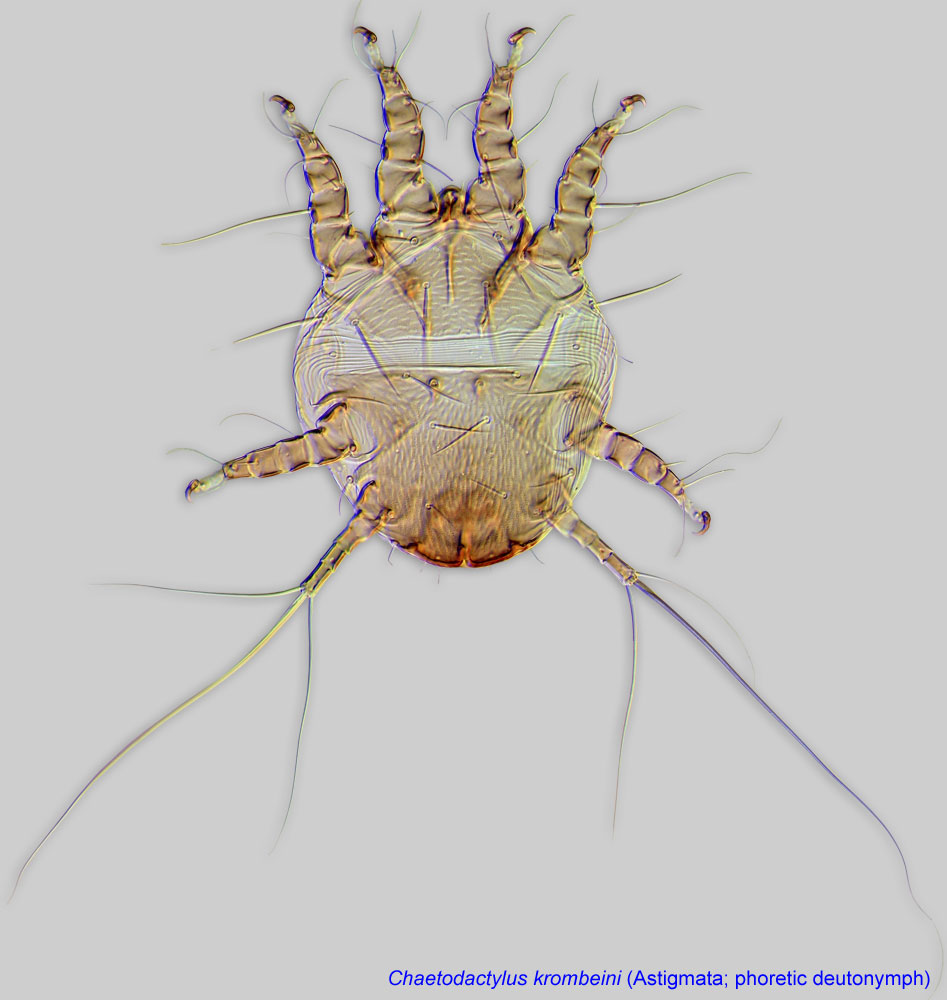 ). External vertical setae (ve) situated on the same transverse line with internal vertical setae (vi), long and barbed (Fig. 10). Genugenu:
). External vertical setae (ve) situated on the same transverse line with internal vertical setae (vi), long and barbed (Fig. 10). Genugenu:
Leg or palp segment (also known as podomere or palpomere) between tibia and femur.
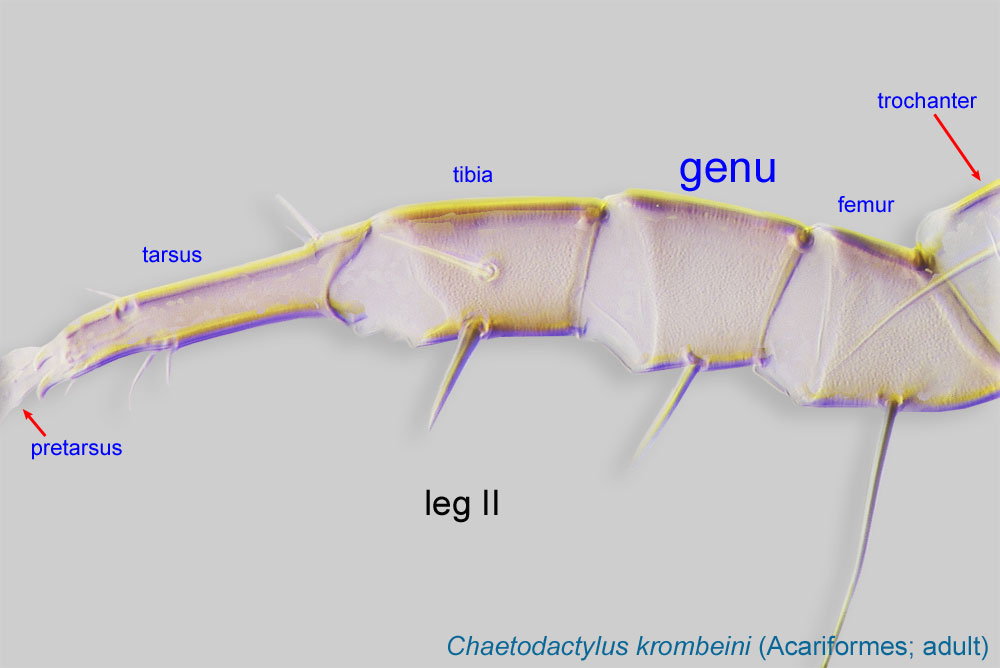 I with solenidionsolenidion:
I with solenidionsolenidion:
Thin-walled, terminally rounded or pointed filiform or peglike structure that is not birefringent in polarized light (unlike common setae in Acariformes). Often appears striated because of its internal structure. Found on the palpal tarsus on the gnathosoma and may also occur on the tarsus and tibia, less frequently on the genu, and occasionally on the femur of legs I-IV. In Acariformes, leg solenidia often arise from unsclerotized areas.
 σ' no more than three times longer than σ'' (Fig. 10). Scapular setae si longer than setae se (Fig. 10). All hysterosomal setae except c1 elongate, longer than the distance to the next posterior seta (Fig 11).
σ' no more than three times longer than σ'' (Fig. 10). Scapular setae si longer than setae se (Fig. 10). All hysterosomal setae except c1 elongate, longer than the distance to the next posterior seta (Fig 11).
Keys to species are not available for this genus. This genus needs a revision. Reliable identification is possible after examining type specimens and DNA sequencing. Taxonomic problems are centered around the European species Kuzinia laevis versus two North American species: Kuzinia affinis and Kuzinia americana. The two latter species have been cited to have a distinctly different number of foliate setae on tarsitarsus:
Terminal segment (also known as podomere or palpomere) of legs or palps. In Parasitoformes it can be subdivided into telotarsus and basitarsus.
 I-IV (Delfinado and Baker, 1976Delfinado and Baker, 1976:
I-IV (Delfinado and Baker, 1976Delfinado and Baker, 1976:
Delfinado, M. D. amp; E. W. Baker. 1976. Notes on hypopi (Acarina) associated with bees and wasps (Hymenoptera). Journal of the New York Entomological Society . 84 : 76-90.). However, our examination of North American specimens (i.e., ex Bombus vagans, Rhode Island) indicate that the morphology of tarsal setae is essentially the same between North American and European specimens. In addition, character states separating Kuzinia affinis and Kuzinia americana (e.g., body length, shape, and length of sternum) may represent allometric effects and/or differences in the pressure applied to specimens during slide preparation. The same problem is apparent in a recent study that reported four species of Kuzinia (including the European species, Kuzinia laevis) associated with two species of bumble bees from Argentina (Revainera et al., 2014Revainera et al., 2014:
Revainera, P., M. Lucia, A. H. Abrahamovich amp; M. Maggi. 2014. Spatial aggregation of phoretic mites on Bombus atratus and Bombus opifex (Hymenoptera: Apidae) in Argentina. Apidologie . 45 : 579-589.).
Nearctic, Palaearctic, Neotropical, and Oriental regions. Introduced to the Australian region (Australia, Tasmania, and New Zealand) with commercial bumble bee colonies used for crop pollination.
primarily associated with bumble bees (Bombus), but can occasionally be found on other bees
permanentpermanent:
associated exclusively with bees or their close relative, wasps; cannot live without these hosts
 disperse and overwinter on adult queen bees. Phoresyphoresy:
disperse and overwinter on adult queen bees. Phoresyphoresy:Occasionally, phoreticphoretic:
Pertaining to phoresy; using another organism (i.e., a host) for dispersal to new habitats. Phoresy can be distinguished from parasitism because feeding typically does not occur during phoresy.
deutonymphsdeutonymph:
Ontogenetic stage between protonymph and tritonymph (or adult, if tritonymph is absent). See <a href="index.cfm?pageID=1720">Life stages page</a> for more details. of Kuzinia can be found on other bees, wasps, other insects, and in rodent burrows (which can be nesting sites for bumble bees). One little-known species described in Kuzinia, Kuzinia sciurina, was reported from a squirrel nest, a non-bee association. "Kuzinia" recki, reported in forest litter, does not belong to Kuzinia.
of Kuzinia can be found on other bees, wasps, other insects, and in rodent burrows (which can be nesting sites for bumble bees). One little-known species described in Kuzinia, Kuzinia sciurina, was reported from a squirrel nest, a non-bee association. "Kuzinia" recki, reported in forest litter, does not belong to Kuzinia.
In nests of bumble bees, Kuzinia laevis mites feed on pollen, honey, bumble bee cocoon material, nest organic debris (Chmielewski, 1969Chmielewski, 1969:
Chmielewski, W. 1969. Obserwacje nad biologią nowego dla akarofauny polskiej gatunku Kuzinia laevis (Dujardin, 1849) (Acarina, Acaridae) [=Observations on the biology of the species Kuzinia laevis (Dujardin, 1849) (Acarina, Acariaae), new in Polish acarofauna]. Polskie Pismo Entomologiczne. Bulletin Entomologique de Pologne . 39 : 603-617.), nematodes, and fungi (R. W. Husband pers. comm. in Grobov, 1978Grobov, 1978:
Grobov, O. F. 1978. Kleshchi medonosnoy pchely ( Apis mellifera L.): ikh znachenie i osnovnue printsypy bor'by s kleschchevymi porazheniyami [=Mites of the honeybee ( Apis mellifera L.): their significance and main principles of control of diseases caused by mites]. Doctor of Sciences (Habilitation) Thesis. 536. Moscow: All-Union Institute of Experimental Veterinary, All-Union Academy of Agricultural Sciences.), without any noticeable harmful effect on their hosts or at the boundary of being a harmless commensal and a pest (Chmielewski, 1969Chmielewski, 1969:
Chmielewski, W. 1969. Obserwacje nad biologią nowego dla akarofauny polskiej gatunku Kuzinia laevis (Dujardin, 1849) (Acarina, Acaridae) [=Observations on the biology of the species Kuzinia laevis (Dujardin, 1849) (Acarina, Acariaae), new in Polish acarofauna]. Polskie Pismo Entomologiczne. Bulletin Entomologique de Pologne . 39 : 603-617.). Large numbers of mites, however, may be of concern for bumble bee colonies introduced for commercial pollination; these bees usually have low genetic variation and hence low disease resistance (Allen et al., 2007Allen et al., 2007:
Allen, G. R., O. D. Seeman, P. Schmid-Hempel amp; R. E. Buttermore. 2007. Low parasite loads accompany the invading population of the bumblebee, Bombus terrestris in Tasmania. Insectes Sociaux . 54 : 56-63.). In literature Kuzinia laevis has also been indicated as a potential pest of pollen harvested from honey bees by humans (Chmielewski, 1991bChmielewski, 1991b:
Chmielewski, W. 1991b. Trzmielolubny rozkruszek Kuzinia laevis (Duj.) (Acarida, Acaridiae) - rozwój i składanie jaj na pyłku zbieranym przez pszczoły [=Bumbebee mite Kuzinia laevis (Duj.) (Acarida, Acaridae) - development and oviposition on pollen collected by bees]. Pszczelnicze Zeszyty Naukowe . 35 : 75-82.).